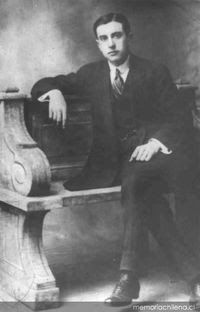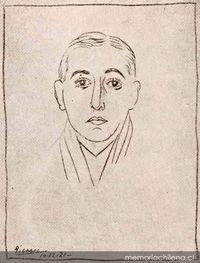The creation of the world in the hands of Vicente Huidobro
In Latin American poetry, Vicente Huidobro was an intrepid writer who did not limit his work to previously established styles. Through words, he sent his readers to new and unknown worlds. At the age of 54, his death in 1948 was a heavy loss for poetic creation in Latin America.

On January 10, 1893, one of the most important Latin American writers for the poetry of the 20th century was born in Chile: Vicente Huidobro. He was the son of María Luisa Fernández Bascuñán -an outstanding figure of Chilean feminism- and Vicente García Huidobro -descendant of an important aristocratic family-.
This favorable ancestry gave the young Huidobro the possibility of spending his first years in Europe -where he would stay with his family for a while- and grow up in a refined and cultured environment that would soon seduce him, inviting him to venture into literature. Vicente Huidobro published -already in Chile- at the age of 18 his first collection of poetry Ecos del alma ( Echoes of the Soul) (1911), where he collected most of the texts he wrote during his adolescence, influenced by modernist aesthetics in force at the time.
"If man has subdued for himself the three kingdoms of nature, the mineral, vegetable and animal kingdoms, why should he not be able to add to the kingdoms of the universe his own kingdom, the kingdom of his creations?"
Despite the modernist affiliation that appears in his early publications, the literary transcendence that Vicente Huidobro would reach years later and that would lead him to become a great writer, began around 1914 when he dictated at the Ateneo de Santiago the lecture Non serviam -which later would become a manifesto- in which he made an innovative poetic proposal:
Non serviam. I am not to be your slave, Mother Nature; I will be your master. You will serve me; it is well. I do not want to and I cannot help it; but I will also serve myself of you. I will have my trees that will not be like yours, I will have my mountains, I will have my rivers and my seas, I will have my sky and my stars. And you will no longer be able to say to me: "That tree is bad, I don't like that sky.... mine is better".
I will answer you that my skies and my trees are mine and not yours and that they don't have to look alike. You will no longer be able to crush anyone with your exaggerated pretensions of an old, spoiled old lady. We have escaped your trap.
With these words he anticipates some core ideas that will structure, years later, the aesthetics of Creationism -a Latin American literary avant-garde created and led by Vicente Huidobro himself- that will transcend the borders of the continent and take to France and Spain the first Hispanic-American avant-garde aesthetics.

By 1917 Vicente Huidobro is an already consolidated poet who has not only theoretically outlined his ideas on Creationism, but has developed them in several poems in which prevails his refusal to "sing" or "imitate" nature, and on the contrary proposes that the poet becomes a "little God" that gives life to new concepts and ideas that beyond speaking of nature, create a poetic world possible only within the universe of the poem and the poet. Such is the case of his composition entitled Arte poética ("Poetic Art") in which he points out:
[...]Why do you sing the rose, O Poets! Make it bloom in the poem; for you alone live all things under the Sun. The poet is a little God.
With this new aesthetic under his arm, Vicente Huidobro traveled to France and Spain in 1917 and 1918, respectively, where he met and became friends with several painters and writers representing the European avant-garde such as Guillaume Apollinaire, Tristan Tzara, Jean Cocteau, André Breton, Pablo Picasso, Juan Gris, Francis Picabia, Joan Miró, Max Ernst, Paul Eluard, Rafael Cansinos-Assens, Ramón Gómez de la Serna, among others. The friendship with these intellectuals and artists, as well as the fluctuation between France and Spain allowed him to venture into the great circles of European culture leading him to enrich and consolidate his idea of creationist poetry, which reached its peak with the publication of the work Altazor o el viaje en paracaídas (Altazor or the parachute trip) (1931).
Vicente Huidobro wrote En la luna ("On the Moon"), a puppet play divided into four acts and thirteen scenes, with intentionally political content.
This is a long poem divided into seven cantos that address various themes: they raise the work of the artist, pay homage to the beloved woman, and completely disarticulate the language attending only to the phonetic. All this creates a vast poetic universe in which metaphors and images are unique and unrepeatable. In this way, Huidobro takes to the maximum his theory of Creationism in which, like God, he creates a world in seven cantos.
In 1934 Vicente Huidobro published "Cagliostro", which he defined as a novel-film and for which he received an award in a screenplay contest held in Hollywood.
Around 1930 Vicente Huidobro alternates his stay between Europe and Santiago de Chile. When the Spanish Civil War breaks out, he participates in the Congress of Antifascist Writers; and years later he serves as a correspondent for the French army during World War II. The activity of the following years is concentrated both in Chile and in Europe, places where Huidobro is dedicated to publishing several poetic works, both in Spanish and French, founded magazines, and participates in political affairs of his native country. After all this activity, he retired to Cartagena, where he died suddenly in 1948 of a stroke.

In the field of Latin American poetry, Vicente Huidobro was a fearless writer, who did not limit his work to previously established styles. Through words, he sent his readers into new and unknown worlds. As he explained in 1916, "the first condition of the poet is to create; the second, to create, and the third, to create." His death in 1948, at the age of 54, meant a heavy loss for poetic creation in Latin America, but the influence he left on Hispanic letters means that his voice has not been silenced.
Summary
The creationist, the parachute traveler, Vicente Huidobro was born in Santiago, Chile in 1893. With a talent never in doubt, after his primary education at home -under the care and teaching of governesses- and his secondary education at the Colegio de San Ignacio de la Compañía de Jesús, he traveled around Europe, and in 1916 he arrived in the mystical and noisy city of Paris where he met art figures such as Pablo Picasso and Joan Miró. He wrote in magazines with Apollinaire, Tzara, Breton, and other great French literary figures in vogue.
This is what Vicente Huidobro tells us. He creates; he gives himself to his poetry with the vitality of a tree and competes against mother nature side by side and verse by verse. His inspiration is born in Paris from the soul of a Chilean, but it is a saying because creationism is not "created", but "begotten" from the things that always existed in any corner of the universe.
Besides his wonderful poem Altazor, in Vicente Huidobro's bibliography we find titles such as Cagliostro, Papá o El diario de Alicia Mir, En la Luna, Temblor de cielo, La próxima. Always unmistakable, but always versatile, the poet puts aside the words that try to capture his essence with haste or rapture, so let's just say that his work speaks for itself, is described as a mural of a thousand colors and discovers more the soul of its author than the biography.
Vicente Huidobro died on the coast of Cartagena on January 2, 1948; the writer's epitaph reads: "Open this tomb. In the background you can see the sea"; and the truth is that the tombs of poets like this have never been closed...
Sources: UNAM Radio, Authors: Ana Gabriela Vázquez and Luis Perea, Images: Chilean National Library.




